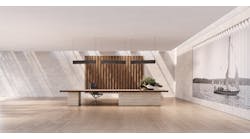ACOUSTICS 101 SERIES: Part 1 / Part 2 / Part 3 / Part 4 / Part 5 / Part 6 / Part 7
What a wondrous thing a good hotel is! Luxurious, comfortable, and well appointed. With room service, a spa, yoga studios, gyms – not to mention conference and business centers. It’s an all-encompassing, full-service environment.
Of course, they come with acoustical issues. Designers today need to know how to nix hospitality noise issues, including how to successfully address the challenges and specifically how to best use drapery textiles in a new, highly effective manner.
Acoustics plays a large role in both the personal and business side of hotels. Whether you’re having a private conversation with loved ones or being romantically intimate, it’s important that your neighbors don’t hear what you’re saying or doing. In business, it’s important that sensitive meetings and conference calls stay private and that the content of conversations stay within the confines of the walls.
The rules of acoustics remain the same for hotels as they do for residences, studios, or symphony halls: Acoustic signature is the quality of sound with acoustic isolation being the degree which barriers can prevent sound from passing from space to space. Both are paramount in a hotel setting. How sound creates the feeling of comfort and luxury is a direct result of acoustic signature design, while having the privacy to not being heard outside one’s space is 100-percent about acoustic isolation design.
Short of entertainment industry production facilities and military grade governmental buildings, hotels require the highest level of acoustical performance anywhere.
Acoustics Signature: Traditional and Quantum Solutions
Let’s start with the easiest topic; the one that has been solved with recent advances in quantum technology – acoustic signature. Specific materials and products can create a quiet, comfortable-sounding setting which works for all types of fun and business: watching TV, listening to music, having a party or romantic evening, conference calls, business meetings, or simply relaxing or sleeping.
Traditional solutions include plush, open weave carpets to control high-frequency reflections of the floor. Leather couches and soft-cloth throw pillows combined with textured wallpaper help control open spaces and sound bouncing off walls.
Ceilings are challenging. Textured paint is unattractive aesthetically and marginally effective, yet better than flat painted drywall. Wallpaper on ceilings is more expensive but slightly more effective. Cloth covered absorption (the best traditional solution) is expensive and laborious, though effective.
Quantum devices are the most effective of all acoustic products, creating not just comfort, but also clarity and intelligibility with the same device. Be aware – ceilings have the most fenestrations and technology of any surface in a room. In addition, all work on ceilings must be done on a ladder. Between these two challenges, it makes ceilings the most complex and difficult area to control. Yet they have no rugs, furniture, or artwork on them, so they are, in fact, the most convenient area in which to control acoustics. Not necessarily the best, but the most convenient.
Acoustics Isolation
The second and more difficult topic is acoustic isolation. You’ll remember that isolation is the key to privacy. It’s how we design building structures to keep sound from getting in or out of spaces. It’s a delicate and specific blend of architecture, materials science, and physics. There’s the classic mid-century dual (10”-14”) or triple wall (15”-19”) structures which worked for their time. Then came staggered stud walls (7”-11”) that decreased overall footprint space while giving the same performance.
Today, new designs utilize existing wall structures to create Isolation walls 62 percent thinner (3.75”) with 100-percent greater performance, including increased low-frequency rejection for those pesky truck and airplane rumbles, or the hotel neighbor with a penchant for electronic music with lots of bass. New technology, new designs, new performance. It’s all about design, materials, and how to use the right tool for the right job.
Using Window Fabrics to Control Sound & Acoustics
One specific question comes up repeatedly. “Why can’t I just hang thick curtains up to control all my sound?” If your intention is to create a beautiful French-Goth velvet cave, you’re fine – otherwise your interior designer and architect won’t be pleased. Secondly, off-the-shelf materials for drapery have absolutely zero effect upon any sounds besides the highest frequencies. In other words, nearly 75 percent of all sound we hear will walk right through that drape like a cannonball through newspaper. If the only issue is upper high-frequency reflections, then by all means, create thick, dual-sided, 40-ounce velvet drapes and hang them around the entire room, as well as on the ceiling.
However, a truly effective, innovative solution is a drape made with existing textile manufacturing technology embedded with a quantum design. This hybrid-quantum drape is twice as effective and controls twice the frequencies, yet is only 1-mm thick and has the hand of standard textiles.
All draperies have a finish side and a backing side: the finish side faces inward toward the room where you can see it, while the backing side faces the windows or walls. This aesthetic function requires two layers of textile, allowing for the hybrid-quantum effect of the drape to occur.
The hybrid-quantum drape applies complex math into the very weave of the textile, using fractal scaling and Fibonacci-chaotic inspired variations. By deconstructing or disrupting the wave behavior of the air molecules, the sound energy riding on the wave simply vanishes. The end result is excellent control of high and mid frequencies in a beautiful, ultra-thin acoustic device.
These new technology drapes can hang over windows, walls, or be used as dividers in large rooms. The more surface area they are applied to, the greater the acoustical performance and, consequently, better the sound.
The Next Wave of Acoustic Fabrics: Nano-Textiles
In the near future, the marriage of quantum acoustics and materials science will create an entirely new field: Nano-textiles. Unlike traditional acoustics, they will defy classical Newtonian physics by controlling all frequencies across the entire hearing range (20 hz – 20 kHz) with a 1-mm thick multilayered Nano-textile. They may be woven from Nano-fibers or made as a compound like Gallium Nitride is for LED’s. As a bonus, they may have additional characteristics, which may be of benefit besides just aesthetics and acoustics.
In Summary
At the end of the day, it seems we have many of the right tools but aren’t using them wisely for the job at hand - but we can change that. We simply need to apply the right designs for the right job. New, highly effective hybrid-quantum devices can be made using existing textile looms – repurposed to create acoustic draperies, carpet, or even wallpaper.
In the not-too-distant future, the field of Nano-textiles will give rise to a cornucopia of pure quantum textiles; beautiful and effective beyond our imagination, like a cloak of inaudibility by Chanel. Harry Potter eat your heart out. Quantum designs, nano-textiles, and quantum fabrics create higher performance in ultra-thin, lightweight and aesthetically pleasing form factors.
Welcome to the future of Acoustics.
ACOUSTICS 101 SERIES: Part 1 / Part 2 / Part 3 / Part 4 / Part 5 / Part 6 / Part 7
Hanson Hsu is the principal acoustician and founder of Delta H Design Inc. (DHDI), a research, design, and build firm providing design and consulting services for architecture and acoustics since 1998. Clients include Universal Music Group, Yahoo Music, Microsoft Studios, LinkedIn, Kanye West, U2, Cher, and more. DHDI specializes in facility design, studio design, transportation, products, and technology innovation using the revolutionary ZR Acoustics design paradigm based on Quantum Acoustics.
For more on Hanson Hsu and DHDI, please visit deltahdesign.com


